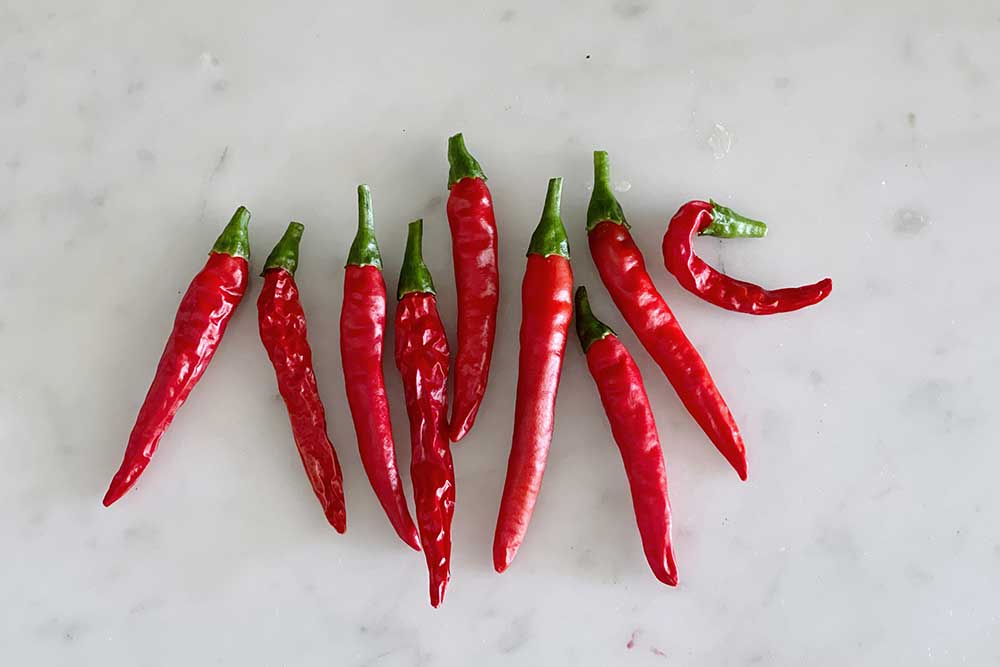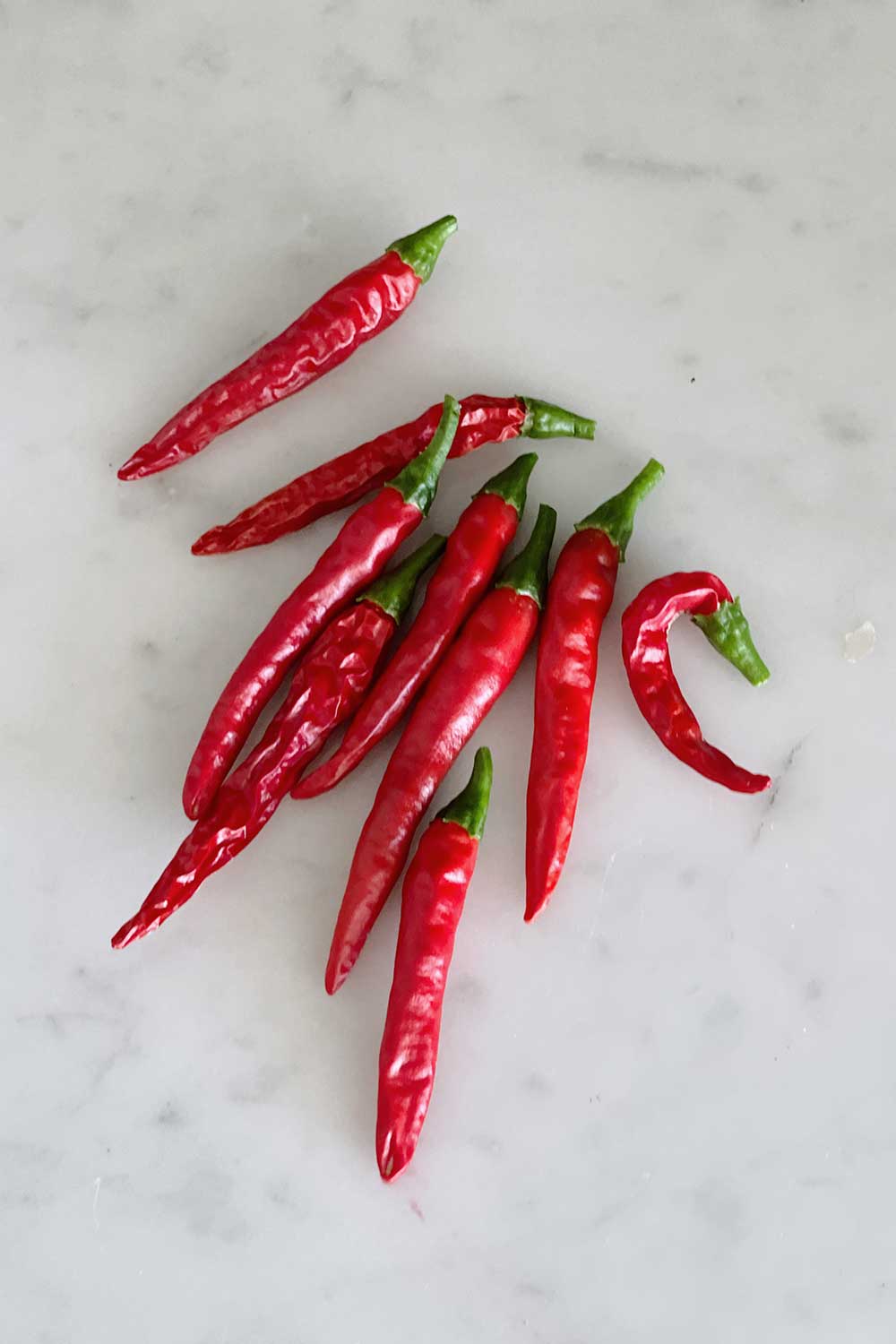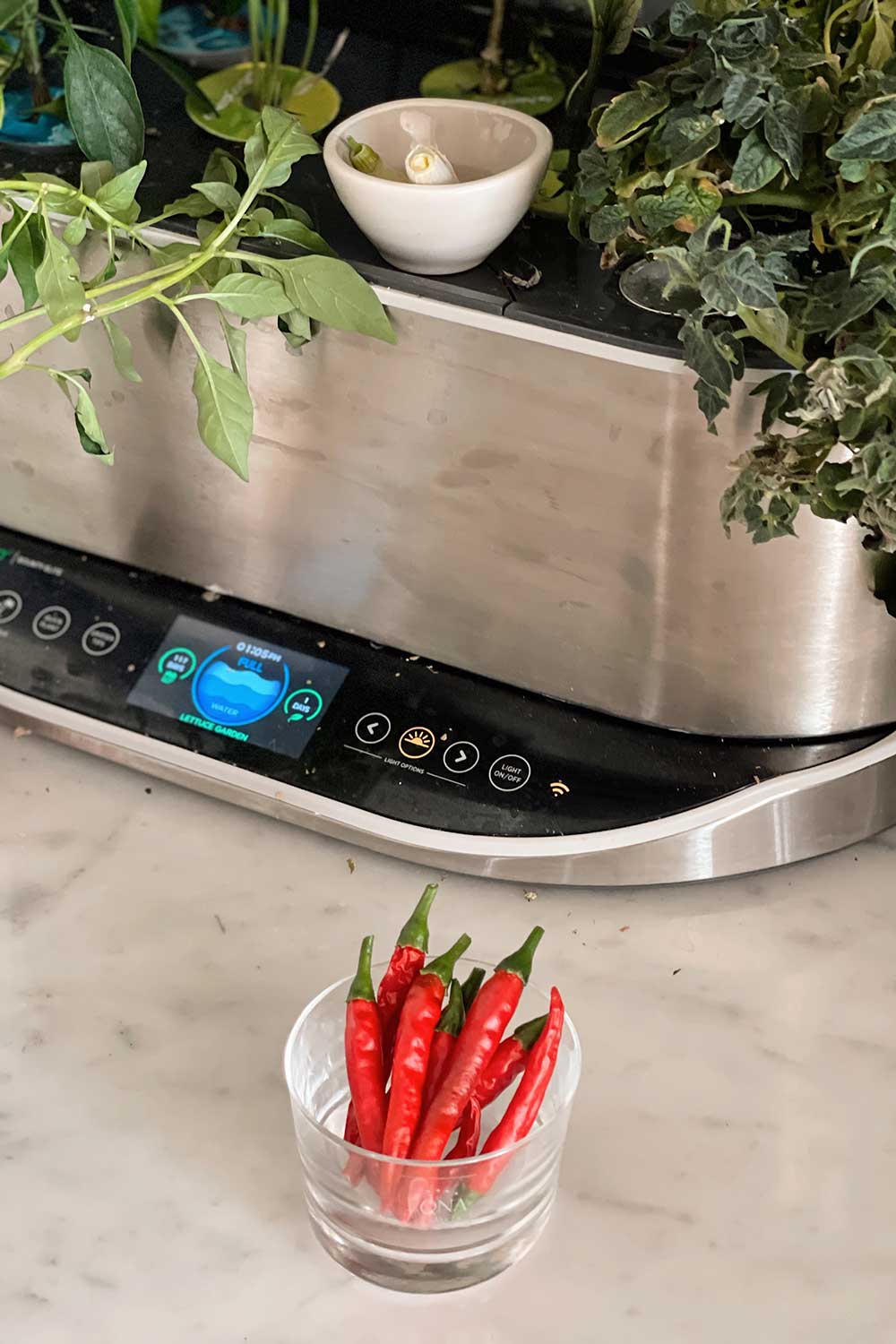Looking to grow Korean hot peppers? These small spicy peppers are the kick behind classic Korean recipes like kimchi, sundubu and bibimbap. Korean chili peppers are easy to grow and extremely productive!

Korean Hot Pepper
Peppers are a staple in Korean cuisine.
There are a couple different types, but somewhat confusingly, they’re commonly referred to as just cheong-gochu or ‘peppers’.
You have the largish green pepper, that’s 4 to 6 inches tall and looks like a longer Jalapeño.
It has thick walled flesh and a sweet flavor, and is often eaten with ssamjang as a crunchy spicy snack.
If you’ve ever had Korean bbq, you might have noticed it on the table of side dishes. It’s eaten as a palate cleanser with all the meat!
You also have the smaller red peppers that pack a kick!
Red peppers are harvested and dried to make pepper flakes and red pepper paste. Think of it as a Korean version of paprika.
Hot peppers are believed to have been brought to Korea from Portugese traders during the Imjin Wars.
But they could also have been introduced via Chinese, Indian and Arab traders along the Silk Route. In just a couple hundred years, peppers became integrated into Korean cuisine.
Today, they’re found in Korean recipes in every form – from dried flakes to savory pastes and whole spices.
The compound capsaicin is what gives the pepper that numbing but pleasant burn.
Capsaicin has been shown to have anti microbial properties and to help with food preservation.
It makes sense that Korean red pepper is an integral ingredient in making kimchi.
In Korea, chilis are a summer crop.
They’re planted in spring, and green chilis are harvested to eat fresh. By late summer, the chilis have matured to turn red.
One variety is harvested and dried to create chili flakes (gochutgaru), which in turn is used to make gochujang.
If you’ve never tried gochujang, or Korean red pepper paste, you’re missing out!
The dark red chili paste has a unique flavor. It’s spicy but not too hot, with a deep savory flavor and thick paste consistency.
Growing Korean Chili Peppers
I love spicy food and especially Korean food.
So I knew I wanted to try making my own Korean chili powder, called gochugaru.
The red flakes are very common in Korean recipes like sundubu-jjigae (soft tofu stew), bibimbap (mixed rice with vegetables) and kkanpunggi (spicy garlic fried chicken).
Korean hot peppers are used both when they’re green (unripe) and red (mature), similar to Thai chilis.
Green Korean chili peppers measure around 1,500 Scoville heat units so they’re not very hot.
It’s common to pickle them, stuff them or eat them fresh with a bit of ssamjang dipping sauce.
By the time the peppers mature into a red color, they’re much hotter!
Dried Korean red pepper is ground into a fine powder in late summer.
I picked up a Korean chili pepper variety from Baker’s Creek. It produced a small, spicy Korean hot pepper that looked similar to a large Thai chili.
But I’m not sure how authentic the company’s Asian seeds are..
I’ve since switched to buying all my Asian vegetable seeds from True Leaf.
Through their partnership with Kitazawa, they have the best selection of authentic Asian vegetable seeds and so far I’ve liked everything I’ve tried.
You can use Korean peppers to make a dried spice powder, chili oil or chili paste!
Buy seeds: Amazon, Etsy & True Leaf Market
Korean Pepper Grow Guide
| Botanical Name | Capsicum annuum |
| Common Name | Korean chili pepper, Korean green chili pepper, Korean red pepper, Korean hot pepper |
| Mature Size | 18-24 inches tall |
| Days to Harvest | 80 days from seed |
| Light | Full sun |
| Soil Type | Rich, well draining soil |
| Soil pH | Neutral (6.0 – 6.8) |
| Hardiness Zones | USA Zones 5-7 |
| Native Area | Asia |
| Pests | Aphids |
| Diseases | Powdery mildew |
Growing Korean Peppers Hydroponically
I grew these indoors in my Aerogarden.
They easily became one of my favorite hot peppers to grow!
I started them in November, directly planting them in my Farm 12xl. Peppers can often be finicky to germinate, so a heat mat and indoor grow lights can help.
Out of all the hot peppers that I grew, this one did the best!
It germinated quickly and took off.
I pruned it a bit in the beginning and it took very well to pruning, creating a compact bush with really dense foliage. This plant likes to grow wide!
This variety of Korean pepper stays quite small, only about 18-24 inches tall.
So, it’s a great hot pepper to grow in containers, small spaces, apartments, condos and of course, indoors hydroponically.
I got SO many peppers off of this!
I was amazed at how many peppers could grow on just one plant.
Each branch easily grew 3-5 Korean peppers and turned from green to red quite quickly. I harvested about 10 chilis right away, to encourage the plant to put out new flowers and fruits.
About two weeks later, I harvested another 30 peppers.
I think I could easily get over 100 peppers off of one plant in a season!
After the first harvest, I topped up with this bloom nutrition to encourage the plant to create even more peppers.
The chilis themselves are quite small, with mild heat.
I was expecting the larger Korean chilis that I’ve seen at H-mart and Asian grocery stores but these look more like a large Thai chili.
So far the Asian vegetable seeds that I’ve bought from Baker’s Creek have all been easy to grow, with high germination rates.
But I’m not so sure they’re the most authentic traditional varieties.
So I’ve ordered some Kitazawa seeds via True Leaf Market and will try those out!
This is an old Japanese company that has been selling authentic Asian vegetable seeds out of California since the early 1900s.
Read more: The Best Place to Buy Heirloom SeedsBest Indoor Gardening Products to Grow Korean Chili Peppers
Indoor Gardens
Use Your Own Seeds
Aerogarden Discount Code
Use SSG15 for 15% off any order of $50+
How to Harvest Korean Peppers
You can pick Korean hot peppers when they’re green for a milder heat profile.
Or, you can let them ripen on the vine and mature to red.
Red Korean peppers will be much spicier!
Red peppers can be dried to create chili flakes or red pepper paste. You can also slice it and add to stir fries and soups for heat.
Young green Korean peppers can be eaten raw, deep fried or stuffed.
They have a crunchy, sweet flavor with a mild kick.
Try to harvest peppers when mature.
If left on the vine too long, they can split or dry out. They also take up the plant’s resources and can prevent the bush from creating new peppers.
How to Store Korean Hot Peppers
You can keep peppers in the produce drawer of your fridge to store them.
You can also dry them to turn into a spice!
Peppers left on the plant will dry out on their own. Or you can pick them and leave them on the counter or out in the sun to dry out.
If you have a dehydrator, use that to dry a whole harvest of peppers at once.
Peppers freeze well too!
Just place them in a freezer bag and take them out as needed for cooking. But, once you freeze them they won’t be great for fermenting or pickling.
more hydroponics + recipes on tiktok @shershegrows
How to Cook with Hot Korean Peppers
I wanted to grow Korean chili peppers to make my own chili flakes and hot sauce.
These are quite small, with heat levels similar to Cayenne, so I’ll be using them as a hot pepper!
You can also use Korean hot peppers in any recipe that calls for Jalapeños or a bit of heat.
Add the dried pepper flakes to homemade kimchi, spicy chicken stir fries or as an extra kick for udon and ramen.
Typically, Korean cuisine uses both the pepper and seeds together.
Korean Pepper Recipes
coming soon!
Follow me on



Thank you so much for this overview! I was aware of some Korean pepper recipes, but this is such a good resource, especially since you got your seeds from the same place.
I’m glad to hear that you were able to successfully grow them indoors because I’m near the end of my outdoor growing season here (and I started my seeds a bit late) and it’d be nice if I was able to extend the growing season a bit by bringing them inside. Thanks for the tips and info!!
Author
glad it was helpful! not sure if you already have seeds, but as an update i would actually recommend True Leaf over Baker Creek! i like the ones i was able to grow from Baker’s Creek but think they’re not quite as authentic / traditional